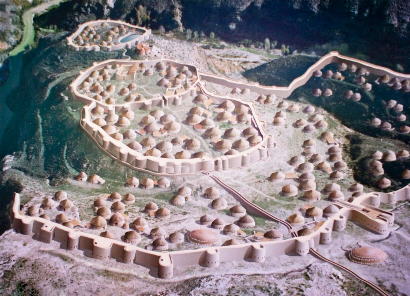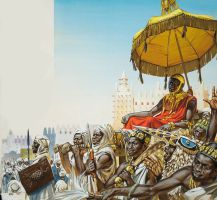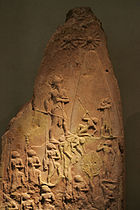++++++++++++++++++++++++++++++++++++
IBERIA CENTERED
++++++++++++++++++++++++++++++++++++

fortified Settlement of Los Millares
| LORDS OF THE EARTH 38 - THE DAWN OF CIVILIZATION | |
| Newsfax Turn: #8 ( 2095 - 2091 BC ) | |
| March 12, 2016 |
|
NILE VALLEY WAR
GM Comments: (1) again, six different nations were involved (Thebes & Herakleopolis vs Minoans, Old Kingdom, Nubia & Meroe). (2) when a region is invaded from two sides, if there are two defending armies they will each confront one invader. If there is one defending army it will be split with half to face each invader. Either response can be overruled by player standing orders. (3) apologies in advance if I missed any contingencies. 2095 BC Kyrsi of the Minoans departs for Knossos with various sized galleys, taking Herakleopolitan prisoners back for slave labor, leaving a large Minoan army to assist the Old Kingdom's defense of Lower Egypt. Over the border the Herakleopolitan army defends Middle Egypt and is reinforced in late spring by several thousand Thebean infantry which proves critical to events. Both sides expect the other to attack but neither does. There are reports of small groups of unknown warriors in the western parts of Middle Egypt. The Meroan army marches south returning home; their swords will be missed several years' hence. A pentaconter squadron under Lonchi of the Minoans protects the crossing of the Nubian army from Aswan to Upper Egypt. Nubian King Shasesi leaves a garrison in Aswan and then crosses the Nile with nearly five thousand mixed swordsmen and skirmishers plus six hundred skilled archers. Once the army was across the Minoan ships moved back downriver to blockade Abydos. The Thebean region was defended by a lone stone fort supported by skirmishers.1 Nubian archers make casualties of most of the skirmishers; the fort was then overwhelmed and the region subjugated by year's end with minimal loss, the victory easing the Nubian warriors' lingering resentment concerning earlier distribution of loot. 2094 BC Again the two sides guard the Middle Egypt/Lower Egypt border, expecting the other to attack. The unknown warriors are identified as men dressed similarly to Minoans and rumors persist they came from the oasis of El-Wahat despite the lack of supply-carrying draft animals who could survive such a trek.2 In Upper Egypt the victorious Nubians approach Abydos planning to storm the port. It had neither walls nor garrison and its elders fearfully surrender the city. To their astonishment it was not put to the sack as Thebes had been. In autumn Herakleopolitan general (and heir) Akhtoy II receives orders from King Sekhimib to move the entire army into Upper Egypt. He has grave misgivings at leaving the homeland almost defenseless and agonizes whether to obey. The issue becomes moot when he collapses during his evening meal 3 and spends many days unconscious and wracked with fever. Afterward he begins a slow recovery during which the move to Upper Egypt is delayed. Kyrsi of the Minoans returns about the same time with eight hundred reinforcements. Plans are made with Scota of the Old Kingdom to invade Middle Egypt in the new year. 2093 BC In early spring over two thousand Minoan infantry and skirmishers along with a thousand archers led by general Lonchi and First Kyrsi cross into Middle Egypt from the north accompanied by almost 2,500 Old Kingdom infantry commanded by heir Scota. The western force numbers only two hundred skirmishers commanded by Dori, a Minoan feudal ally, and conduct hit & run ambushes to sow confusion. Moving in from the south is a Nubian army of nearly four thousand mixed infantry and skirmishers plus six hundred archers under King Shasesi. While Upper Egypt has been garrisoned, Abydos has not and reverts to neutrality.4 Receiving news of serious invasions from opposite directions, King Sekhimib splits the Herakleopolitan-Thebean army to confront both. He leaves the capital and takes command of approximately three thousand infantry to oppose the closer Minoan/Old Kingdom threat. Akhtoy II, still in ill health, is sent with approximately three thousand infantry to deploy against the Nubians, both armies anchoring on three stone forts near the respective violated borders and both using home terrain to advantage. The main forces engaged in the north were three veteran armies 5 with bronze weaponry led by skilled commanders. Minoan archers launched volleys as the invaders closed on the defensive lines inflicting casualties on the defenders. But the attacking armies lack seige engineers and break upon the stone forts and the prepared positions between them, resulting in heavy losses. Over 800 Minoans are killed and twice that wounded while the Old Kingdom lost almost 500 killed and nearly a thousand wounded. Minoan feudal ally Dori was a middling warrior seeking to live up to his "the Magnificent" title; he and his untested household guard are lost in an ambush. The Herakleopolitan-Thebean forces only lose a bit over 400 dead and almost 900 wounded - a very good exchange rate for which the fort garrisons can take credit. Lonchi and Scota realize another assault would destroy their armies.6 Stunned Minoan and Old Kingdom survivors withdraw back into Lower Egypt taking thousands of wounded with them. Meanwhile ... in the south of Middle Egypt both armies have bronze weapons. The defenders are veterans while the Nubians are largely untested: their victories have all been against very small numbers of enemies. Balancing that is King Shasesi being a skilled commander while Akhtoy is still suffering blackouts from his near-death. The Nubians rush the defenders with archers dropping arrows ahead of the charge. But here too the invaders lack seige engineers and take heavy losses scaling the stone forts while the Herkleopolitan-Thebean infantry hammer at their flanks. Nearly a thousand Nubians are slain - including 2nd in command Memeteri - and almost double that wounded. The defenders lose half that many but Akhtoy is among the dead, hit by a random Nubian arrow while viewing the battle. His 2nd in command takes over the defense. Shasesi is wise enough to see his army will be destroyed 6 if he continues so orders his shaken forces to withdraw back into Upper Egypt taking their wounded with them. Demoralized, the warriors' thoughts again dwell on the battlefield booty from past years (and the drinking & wenching it would've made possible) of which they felt they'd been cheated. 2092 BC All armies remain vigilant while their wounded heal. No one attacks. Allied plans for the division of the Herakleopolitan kingdom are abandoned for now. 2091 BC All armies remain vigilant. No one attacks. Kyrsi informs his Minoans they will not be returning home as planned. . |
|
From his army's camp in Aswan, Saba sent orders back to Meroe. All the kingdom's wealth was again spent on
improvements to the homeland: building gristmills, fencing pastures, and making rural travel easier by
bridging small creeks. That underway his orders went out to break camp. He had become king while on campaign
and needed to head home to formally take the throne according to ancient ceremony.
The army moved slowly back to Meroe burdened with gold and agro looted from Thebes and its temple of Amun. Herded along were long lines of shuffling slaves including priests and novices from the pillaged temple. The priests frequently called upon Amun to avenge them but to Saba's amusement no ill luck had befallen Meroe. Upon his return the king sent his younger brother (and heir) Arakemani with nearly two thousand warriors to protect Upper Nubia while the Nubian army was away engaging in further conquest. Saba then married a local noblewoman and ruled his kingdom. His bride birthed a son in 2093 and a daughter in 2092. Life is good the king had thought, but his wife died in childbirth the following year, leaving him grieving. |
 Saba & army return to Meroe
Saba & army return to Meroe |
 |
By the immutable word of Enlil, king of the lands, father of the gods, Jushur of Kish, of
Lagash and Kuda of Uruk
set a boundary to their lands. Kuda, King of Uruk, at the command of his deity Inanna, set up a pillar of
basalt in the plantation of that field which lies at the junction of the lands of Kish and the lands of Uruk.
We are as brothers, the three mighty ones spoke, bowing before the gods. Our lands are as brothers. Our cities are as brothers. If demons of the underworld strike at us, we will grapple them together. If barbarians from far lands cast spears at us, we will raise our shields together. If men of war in bronzed chariots come against us, we shall draw bow and loose shaft together. As brothers we shall defend house, field and city against all enemies. So says Ur-Ningirsu of Lagash, favored of Bau. So says Jushur II of Kish, favored of Zababa. So says Kuda of Uruk, favored of Inanna. |